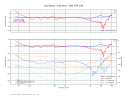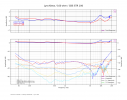mfalcon
Member
- Joined
- Jan 17, 2024
- Messages
- 46
- Likes
- 17
Thanks @JP
I just rerecorded it and got it running. I normalized my files, is that ok?
Now clearly I have a problem but I don't know exactly what's going on. Does anybody see what I did wrong or if it's setup? The crosstalk is positive for the right channel.
This cartridge is 10-20 hours. Its my second Kleos.
Input File: Lyra_Kleos_CBS_STR100_L_2024_02_01.wav
Sample Rate: 96,000Hz
Channels: 2
Length: 72.988875s
In/Out (s): [ 0. 72.988875]
Min Freq: 0Hz
Max Freq: 0Hz
X-talk @1kHz: -22.33dB
Input File: Lyra_Kleos_CBS_STR100_R_2024_02_01.wav
Sample Rate: 96,000Hz
Channels: 2
Length: 64.97380208333334s
In/Out (s): [ 0. 64.97380208]
Min Freq: 0Hz
Max Freq: 20,200Hz
X-talk @1kHz: 23.47dB
I just rerecorded it and got it running. I normalized my files, is that ok?
Now clearly I have a problem but I don't know exactly what's going on. Does anybody see what I did wrong or if it's setup? The crosstalk is positive for the right channel.
This cartridge is 10-20 hours. Its my second Kleos.
Input File: Lyra_Kleos_CBS_STR100_L_2024_02_01.wav
Sample Rate: 96,000Hz
Channels: 2
Length: 72.988875s
In/Out (s): [ 0. 72.988875]
Min Freq: 0Hz
Max Freq: 0Hz
X-talk @1kHz: -22.33dB
Input File: Lyra_Kleos_CBS_STR100_R_2024_02_01.wav
Sample Rate: 96,000Hz
Channels: 2
Length: 64.97380208333334s
In/Out (s): [ 0. 64.97380208]
Min Freq: 0Hz
Max Freq: 20,200Hz
X-talk @1kHz: 23.47dB


